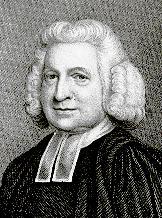Go Ad-Free
If you regularly use Hymnary.org, you might benefit from eliminating ads. Consider buying a Hymnary Pro subscription.
If you regularly use Hymnary.org, you might benefit from eliminating ads. Consider buying a Hymnary Pro subscription.

1 God of my salvation, hear,
And help me to believe;
Simply do I now draw near,
Thy blessing to receive:
Full of guilt alas! I am,
But to Thy wounds for refuge flee:
Friend of sinners, spotless Lamb,
Thy blood was shed for me.
2 Nothing have I, Lord, to pay,
Nor can Thy grace procure;
Empty send me not away,
For I, Thou know'st, am poor:
Dust and ashes is my name,
My all is sin and misery:
Friend of sinners, spotless Lamb,
Thy blood was shed for me.
Amen.
Source: Book of Worship with Hymns and Tunes #397
 Charles Wesley, M.A. was the great hymn-writer of the Wesley family, perhaps, taking quantity and quality into consideration, the great hymn-writer of all ages. Charles Wesley was the youngest son and 18th child of Samuel and Susanna Wesley, and was born at Epworth Rectory, Dec. 18, 1707. In 1716 he went to Westminster School, being provided with a home and board by his elder brother Samuel, then usher at the school, until 1721, when he was elected King's Scholar, and as such received his board and education free. In 1726 Charles Wesley was elected to a Westminster studentship at Christ Church, Oxford, where he took his degree in 1729, and became a college tutor. In the early part of the same year his religious impressions were much deepene… Go to person page >
Charles Wesley, M.A. was the great hymn-writer of the Wesley family, perhaps, taking quantity and quality into consideration, the great hymn-writer of all ages. Charles Wesley was the youngest son and 18th child of Samuel and Susanna Wesley, and was born at Epworth Rectory, Dec. 18, 1707. In 1716 he went to Westminster School, being provided with a home and board by his elder brother Samuel, then usher at the school, until 1721, when he was elected King's Scholar, and as such received his board and education free. In 1726 Charles Wesley was elected to a Westminster studentship at Christ Church, Oxford, where he took his degree in 1729, and became a college tutor. In the early part of the same year his religious impressions were much deepene… Go to person page >| First Line: | God of my salvation, hear |
| Title: | The Poor Sinner |
| Author: | Charles Wesley |
| Meter: | 7.6.7.6.7.8.7.6 |
| Language: | English |
| Copyright: | Public Domain |
God of my salvation, hear. C. Wesley. [Lent] . Published in Hymns & Sacred Poems, 1742, in 8 stanzas of 8 lines, and headed, "After a relapse into sin" ( Poetical Works, 1868-72, vol. ii. p. 200). In its full form it is unknown to the collections, but the following centos are in common use:—
1. In Madan's Psalm & Hymns, 1760, stanzas i., iv. v., are given as No. 10. This is repeated with slight alterations in the Society for Promoting Christian Knowledge Hymns, 1852, and other collections. It was also in R. Conyers's Collection, 1767, and several of the older hymn-books.
2. Toplady's cento in his Psalms & Hymns, 1776, No. 354, of which stanzas iii. and vii. are by Toplady, is not in modern use.
3. Bickersteth's Christian Psalmody, 1833, No. 160, is composed of stanzas i., ii., iv., vi., with slight alterations. This is repeated in the Hymnal Companion with a return to the original text.
4. Mercer's Church Psalter & Hymn Book 1855, consists of stanzas i., ii., iv., vi., viii.
5. Dr. Hatfield's Church Hymn Book, N.Y., 1872, No. 639, embodies stanzas i., ii., iv.
6. The Wesleyan Hymn Book, 1780, No. 168 (new edition 1875, No. 175), is composed of stanzas i., ii., iv., vi., viii. This cento has passed into several Methodist collections.
This somewhat large number of centos (and the most important only have been named) indicate the extensive use which has been made of the hymn from Madan to the present. Of these centos that in the Wesleyan Hymn Book is the best known.
--John Julian, Dictionary of Hymnology (1907)


 My Starred Hymns
My Starred Hymns